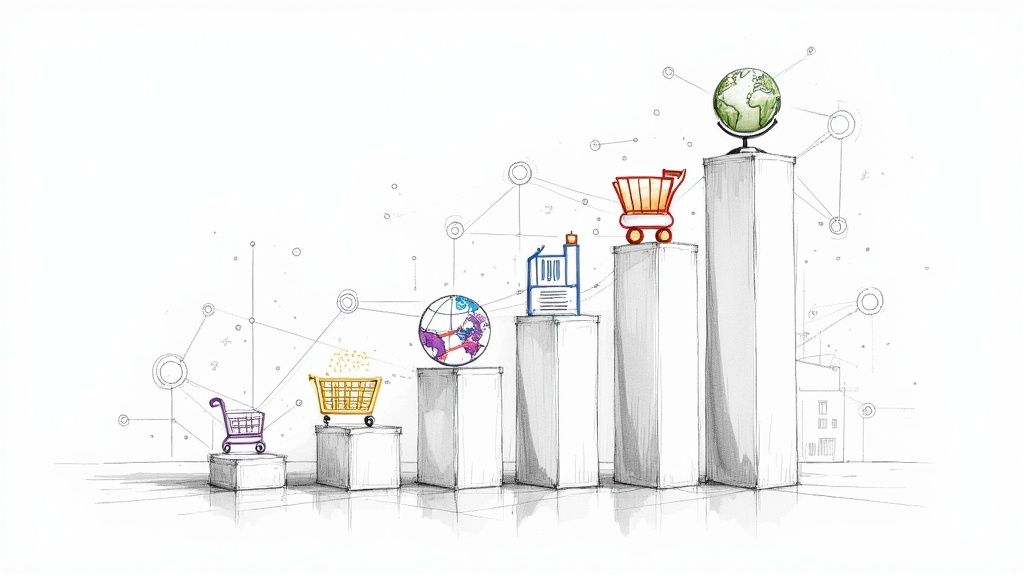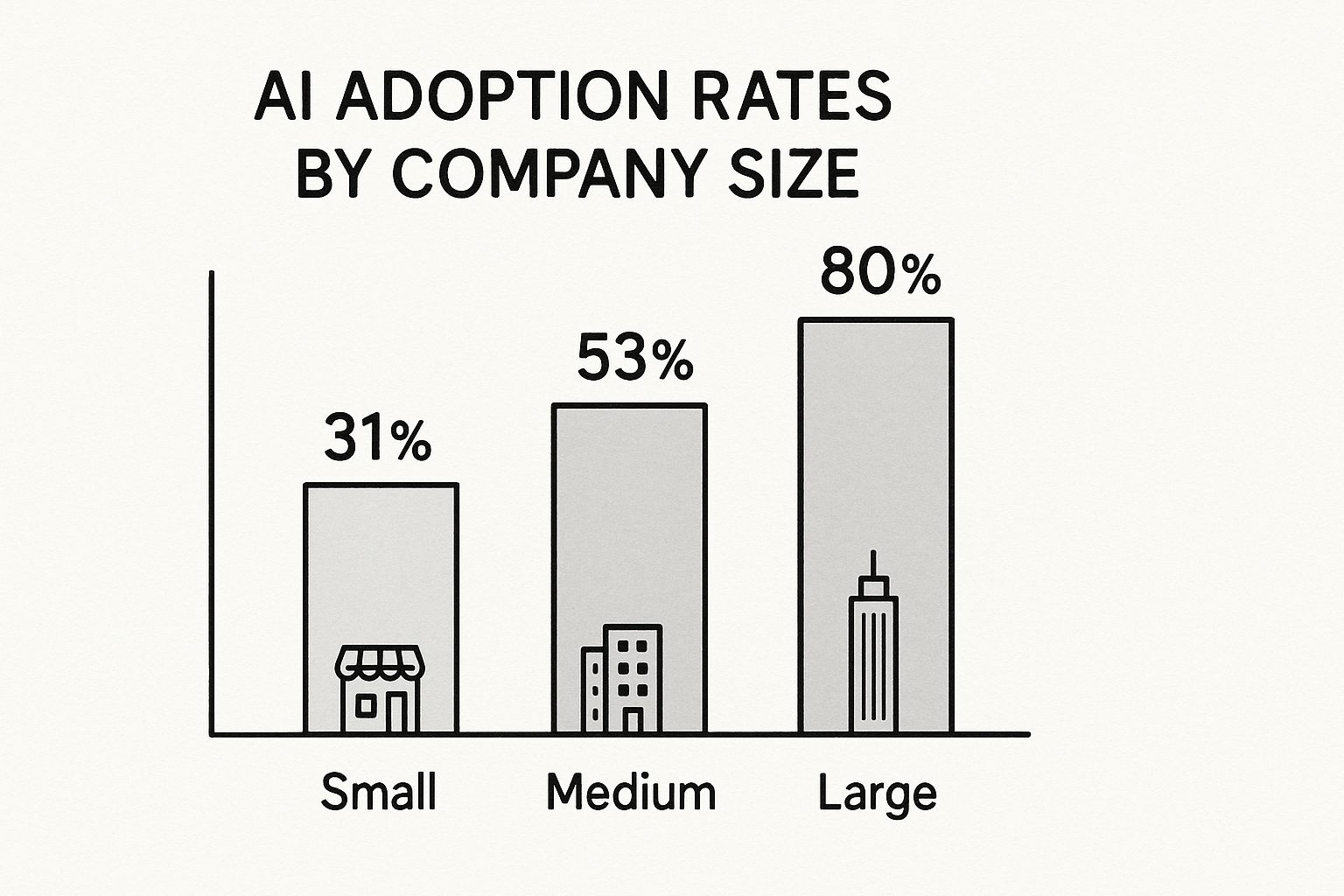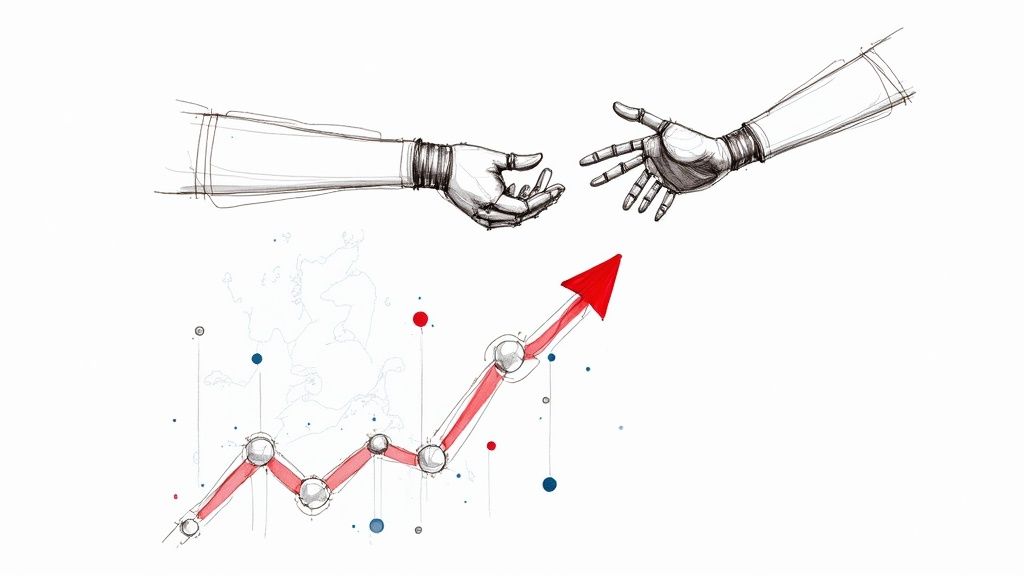AI Adoption Statistics A Guide for Your Business
Explore the latest AI adoption statistics and understand the trends shaping industries. Our guide translates data into actionable business strategy.

The latest AI adoption statistics tell a story that’s impossible to ignore: artificial intelligence isn't some far-off concept anymore. It's here, and it's fundamentally changing how business gets done. Companies all over the world are moving past the "let's try it out" phase and are now weaving AI into the very fabric of their operations to work smarter and innovate faster.
Understanding Today's AI Adoption Landscape
AI has officially hit the big time in the business world. The speed at which companies are getting on board points to a major shift in how we think about technology as a competitive tool. What was once the exclusive playground of tech giants is now a practical, almost essential, tool for businesses of all sizes, shaking up entire industries along the way. This rush is being fueled by real, measurable results and the simple fact that you can't afford to be left behind.
For anyone in a leadership role, these stats are more than just numbers on a page—they're a wake-up call. Getting a firm grip on the current state of AI adoption is the first, most critical step in building a strategy that actually works. The data shows us where and how businesses are putting their money into AI, essentially creating a blueprint for anyone just starting or looking to scale up their efforts. This kind of foundational knowledge is what makes successful AI co creation possible, turning raw data into real-world business wins through smart partnerships.
Global and Regional Adoption Rates
If you zoom out and look at the global picture, you'll see a massive spike in AI implementation. As of 2025, an incredible 78% of organizations worldwide are using AI in at least one part of their business.
But it's not a one-size-fits-all situation. Adoption varies quite a bit from place to place. In Europe, for instance, 13.5% of enterprises were using AI in 2024—a big jump from just 8% the year before. The larger companies are really leading the pack, with 41.17% of them already on board. Over in the UK, businesses nearly doubled their AI usage from 9% in 2023 to a predicted 22% in 2024. Meanwhile, U.S. firms started 2025 with a slightly lower adoption rate of 8.7% but remain dominant forces in the global AI arena. You can dive deeper into these regional AI adoption trends to see the full picture.

To really drive home what these numbers mean, here’s a quick look at the most important metrics.
Key AI Adoption Statistics at a Glance
This table provides a snapshot of the most significant AI adoption metrics, covering enterprise usage, user base growth, and overall market value.
| Metric | Statistic | Key Insight |
|---|---|---|
| Enterprise AI Usage | 78% of organizations use AI in at least one function. | AI is now a standard operational tool, not just an experiment. |
| Global AI User Base | 378+ million regular users of AI tools. | People are comfortable with AI at home, which speeds up its use at work. |
| AI Market Value | ~$391 billion in 2025. | The huge investment shows a strong belief in AI's return on investment. |
| Projected Market Growth | Expected to reach $1.81 trillion by 2030. | We're still at the beginning of the AI boom. |
The data paints a very clear picture: AI is a powerhouse shaping modern business. The big takeaway here isn't just that a lot of companies are using AI, but that how they use it is what separates the leaders from the laggards. That's where a sharp AI strategy consulting approach becomes absolutely essential for navigating this new landscape.
How AI Became a Mainstream Tool
It's not just happening in the boardroom. The real story behind AI's rapid ascent is a massive, consumer-led revolution that has pushed artificial intelligence squarely into our daily lives. What was once a niche technology for researchers and giant corporations is now a common tool, largely because it's become so much easier to access and use.
This widespread personal use has created a powerful ripple effect. When people are already comfortable using AI at home, they bring that familiarity—and those expectations—with them to work. This bottom-up momentum is a huge reason we're seeing companies adopt AI so quickly, turning individual curiosity into full-blown organizational strategy.
The Scale of Consumer Adoption
The numbers are pretty staggering when you look at how many people are using AI on a daily basis.
As of 2025, it's estimated that over 378 million people around the world are regular users of AI tools. To put that in perspective, that's 64 million new users added just since 2024. This figure has more than tripled from only 116 million five years ago, which shows just how explosive this growth has been. To fully appreciate this shift, it helps to understand what AI means in a business context and how this consumer familiarity is reshaping the workplace.

But this rapid expansion also highlights a critical trend that businesses need to pay close attention to: the monetization gap.
Despite the massive user base, only about 3% of AI users are currently paying for premium services. Even a giant like ChatGPT only converts about 5% of its weekly active users into paying subscribers.
This points to a significant disconnect between how much people are using AI and how willing they are to pay for it directly.
So, what does this mean? For starters, it signals that while people clearly see the value in AI, the idea of paying for it is still taking shape. For businesses building AI tools, this suggests that the current value proposition might need a rethink to build a sustainable revenue model. It also hints that a smarter strategy might be to integrate AI features into existing products people already pay for, rather than trying to sell a standalone AI subscription.
Understanding these consumer trends is absolutely essential for any company trying to build an effective AI strategy. The way individuals are engaging with AI provides a roadmap for everything from product development to marketing, ensuring that what you build actually aligns with what users expect and need. This isn't just a bunch of statistics; it's a fundamental shift that's changing how businesses approach technology and innovation from the ground up.
The Economic Forces Fueling AI Growth
It's impossible to ignore the surge in AI adoption statistics lately. This isn't just another tech trend; it's a fundamental economic shift. What was once a high-cost, experimental playground for tech giants is quickly becoming an accessible, even essential, tool for businesses everywhere.
The driving force is a massive expansion of the market itself. In 2025, the global AI market is sitting at around $391 billion, but it’s expected to explode to $1.81 trillion within the next five years. That kind of growth doesn't happen in a vacuum. It's happening because costs are coming down across the board, making AI practical for a much wider audience. For a deeper look, check out these trends shaping the global AI market.

Putting AI Within Reach
Three key factors are chipping away at the financial walls that once kept most companies out of the AI game. It’s a perfect storm of accessibility.
- Hardware Is Getting Cheaper: The specialized hardware needed to run powerful AI models is seeing its price drop by about 30% every year. This drastically lowers the upfront cost to get started.
- Running AI Costs Less: The expense to actually use a large language model—what's called the inference cost—has plummeted. As a reference, the cost to use a system like GPT-3.5 fell by an incredible 280-fold between late 2022 and late 2024.
- Efficiency Is Improving: Newer AI chips are built for better energy efficiency, which cuts down on the long-term operational costs of running these systems at scale.
When you put these pieces together, the return on investment for AI becomes much clearer and faster. It’s no longer a massive, risky bet. Companies can now use AI-powered tools like a financial insights dashboard to track performance without needing a venture-capital-sized budget.
AI Is Now a Business Imperative
The economic argument for AI has become so strong that it’s now a C-suite conversation. A staggering 87% of companies now consider AI a top strategic priority. This isn't just about saving a few bucks; it's about staying competitive in a world that values efficiency and innovation above all else.
The conversation in the boardroom has completely changed. It’s no longer, "Can we afford to implement AI?" It's now, "Can we afford not to?"
This shift is putting a lot of pressure on leaders to make their move. But jumping in without a plan is a recipe for failure. Getting expert guidance through AI strategy consulting can help turn these economic opportunities into a concrete roadmap for success.
The numbers don't lie. The economic winds are now firmly at AI's back, and businesses that understand these financial drivers are the ones that will be best positioned to lead.
AI Adoption Trends in Key Industries
While the overall numbers on AI adoption are impressive, the real story is in the details. When you look closer, you see that certain industries are pulling way ahead of the pack. They're not just experimenting with AI; they're actively using it to solve old problems in new ways.
Finance, manufacturing, retail, and healthcare are the clear front-runners, but they're all on different tracks. A bank is using AI to stop fraud in its tracks, while a factory is using it to predict when a machine will break down. This is where AI stops being a buzzword and starts creating real value.
A Closer Look at Industry Leaders
Each of these leading sectors is putting AI to work on its biggest headaches.
Take the financial services industry. They're pouring a staggering $20 billion a year into AI, with a huge chunk of that going toward sophisticated fraud detection systems. At the same time, 77% of manufacturers have embraced AI, primarily for predictive maintenance. Being able to anticipate equipment failures has cut their downtime by an average of 23%. That’s a massive win for productivity.
Retailers aren't far behind. They’re now dedicating 20% of their technology budgets to AI, mostly to craft those personalized shopping experiences we're all getting used to. AI-powered chatbots, for example, have been shown to boost sales conversion rates by as much as 15% during busy shopping periods.
But the industry with perhaps the most explosive growth is healthcare, which is seeing a 36.8% compound annual growth rate in AI adoption. The focus here is squarely on patient outcomes—from smarter diagnostics to more efficient patient management.
Of course, adoption isn't just about the industry; it's also about company size. The big players have the resources to go all-in, while smaller companies are often more cautious.

As you can see, large enterprises are leading with an 80% adoption rate, giving them a significant head start. Small businesses, at just 31%, are just getting their feet wet.
The table below breaks down how these key industries are putting AI to work, showing just how different their priorities and maturity levels are.
AI Adoption and Use Cases by Industry
| Industry | Adoption Rate (High/Medium/Low) | Primary AI Use Case | Key Business Impact |
|---|---|---|---|
| Finance | High | Fraud detection & risk management | Reduced financial losses and improved security compliance. |
| Healthcare | High | Diagnostic imaging & predictive analytics | Faster, more accurate diagnoses and personalized patient care. |
| Manufacturing | High | Predictive maintenance & quality control | Decreased equipment downtime and fewer product defects. |
| Retail | Medium | Customer personalization & supply chain optimization | Increased sales conversions and more efficient inventory management. |
This comparison makes it clear that there's no one-size-fits-all strategy for AI. Success comes from identifying the most pressing business need and finding the right AI tool for the job.
The Power of Specialized AI Solutions
Healthcare is a fantastic example of just how powerful specialized AI can be. Today, 42% of major healthcare networks use AI-powered chatbots to handle initial patient questions. This simple application frees up nurses and administrators to focus on more urgent patient needs. It's a targeted solution for a specific industry problem.
If you want to dive deeper into this area, you can find more on AI's growing role in healthcare to see just how integral it's becoming.
This is why we're seeing a rise in services like specialized healthcare software development. These aren't generic AI tools; they're custom-built solutions designed to analyze medical images or create unique treatment plans. AI is becoming a core part of modern medicine, and the lessons learned in these leading industries are creating a roadmap for everyone else to follow.
What These AI Statistics Mean for Your Business Strategy
The numbers are clear, but let's be honest—raw AI adoption statistics are just part of the story. The real magic happens when you turn those big-picture trends into a concrete plan that actually moves your business forward. It's one thing to know what's happening out there; it's another entirely to use that knowledge to create a real competitive advantage.
This is where you shift from being an observer to being a player. It's time to pinpoint specific, high-impact opportunities hiding within your own operations.
First, you have to look inward. The statistics tell us that the most successful companies aren't chasing AI for the sake of shiny new tech. They’re applying it to solve nagging, real-world problems that slow them down.
Think about your own business. Where are the friction points? Is it the soul-crushing administrative tasks that eat up hours? The clunky, inefficient workflows that everyone complains about? Or maybe it's the feeling that you're flying blind, making big decisions without solid data to back them up? Answering these questions is the first step to figuring out where AI can make an immediate, noticeable difference.
Making a Rock-Solid Business Case for AI
Once you’ve zeroed in on a few problem areas, you need to build a business case that’s impossible to ignore. This isn’t about making a vague list of potential perks; it's about putting hard numbers to them. A strong business case connects every proposed AI initiative directly to the metrics that matter: revenue growth, cost savings, and happier customers.
To make your argument airtight, focus on these three things:
- Calculate the Projected ROI: Don't just say it will save money; show it. Estimate the financial return by stacking the cost of implementation against the expected gains. For instance, how many work-hours and dollars could you save by bringing workflow automation into your finance department?
- Map Out Efficiency Gains: Get specific about how AI will untangle your processes. This could be as simple as improving internal tooling to finally kill off manual data entry or as complex as deploying smart systems to optimize your entire supply chain.
- Define Your Competitive Edge: Explain exactly how this investment will help you leapfrog the competition. Will it be through better customer service, faster innovation, or just running a much leaner operation?
The best AI strategies never start with the technology. They start with a deep understanding of a business problem and a clear vision for how AI can solve it. This mindset ensures every dollar you spend is tied directly to a result you can measure.
A clear strategy is what turns these insights from ideas into reality. To help you map out your path and take advantage of these trends, a Custom AI Strategy report can give you a roadmap tailored specifically to your business goals. It’s designed to get you from planning to action with confidence, setting the stage for you to explore powerful solutions like AI Automation as a Service to make it all happen.
What's Next for AI in Business?
If you look past today's AI adoption statistics, a clear picture starts to form. The future isn't about simply plugging in another AI tool; it’s about weaving artificial intelligence directly into the very fabric of how a company operates. We’re moving beyond one-off projects and into an era where AI is a fundamental part of core business processes.
You can bet that generative AI will keep popping up everywhere, becoming a standard feature in the software we use daily, no matter the industry. But as it becomes more common, the conversation is shifting to AI ethics and using it responsibly. Companies will have to get serious about building solid governance frameworks to handle the real risks—things like data bias, intellectual property snags, and privacy concerns. In fact, getting this right will soon become a major competitive advantage.
Getting Ready for What's Coming
So, how do you stay ahead of the curve? It really comes down to creating a culture that never stops learning. To prepare your workforce for what's next, you need to invest in the uniquely human skills that AI can't replicate: critical thinking, creative problem-solving, and a solid understanding of data. As we explored in our AI adoption guide, this is crucial.
On a practical level, you'll need a structured approach to innovation. Building out a formal AI Product Development Workflow is key to turning a good idea into a solution that can actually scale. For a closer look at what's just over the horizon, you can explore detailed insights on the future of AI in business intelligence.
This isn't a "wait and see" situation. It requires a proactive, strategic mindset. The organizations that start preparing their teams and processes now are the ones that will be in the best position to seize the next wave of AI-powered opportunities.
The future isn't about simply using AI; it's about building an organization that thinks with AI. This requires a fundamental shift in strategy, culture, and execution—moving from piecemeal adoption to holistic integration.
Figuring out this new terrain requires both expertise and a clear vision. If you're ready to build a forward-thinking strategy that aligns with these emerging trends, connect with our expert team and let's start your AI journey with confidence.
Frequently Asked Questions About AI Adoption
What percentage of companies are using AI?
Currently, about 35% of companies report using AI in their business operations. This number is rapidly increasing as more businesses recognize AI's potential for driving efficiency and innovation.
Which industries have the highest AI adoption rates?
The technology, financial services, and healthcare industries are leading the charge in AI adoption. They leverage AI for everything from cybersecurity and fraud detection to personalized customer experiences and diagnostic imaging. As we explored in our AI adoption guide, these sectors have found clear, high-impact use cases.
How can a small business start with AI?
For a small business, the key is to start small and focus on a specific problem. Begin by identifying a single, high-impact area where AI can help, such as automating customer support, optimizing inventory with workflow automation, or improving internal tooling. Using readily available AI tools for business is a great first step.
What are the main challenges to AI adoption?
The biggest hurdles companies face when adopting AI include a lack of skilled personnel, concerns over data quality and privacy, and the initial cost of implementation. Building a clear strategy and starting with a small-scale pilot project can help overcome these challenges.
How do I measure the ROI of an AI project?
To measure the return on investment (ROI) of an AI initiative, you should track key performance indicators (KPIs) directly related to the problem you're solving. This could include metrics like reduced operational costs, increased revenue from personalized marketing, higher customer satisfaction scores, or improved employee productivity. A Custom AI Strategy report can help define these metrics from the start.
Ready to stop just reading about AI and start doing something with it? Ekipa AI creates custom AI strategies and handles the execution from start to finish, helping you find and act on real opportunities. Get your custom AI strategy and meet our expert team to start building your future today.



